When people think of Pisa, the iconic Leaning Tower often monopolizes the spotlight, overshadowing the city’s myriad other treasures. This article delves into why Pisa is much more than its tilted marvel, unveiling ten compelling reasons to extend your stay in this Tuscan gem with the 10 best other Pisa attractions to see.
Pisa is worth so much more than a short stop to see the Leaning Tower while on your way elsewhere.
In our quest to uncover Pisa’s hidden and not-so-hidden gems, we traversed its ancient streets, engaged with locals, and explored beyond the postcard-perfect Leaning Tower Each step revealed a city steeped in history, bursting with cultural richness, and offering a plethora of reasons to linger longer.
From serene botanical gardens to bustling market squares, our list is a testament to Pisa’s diverse allure, painstakingly curated to inspire both the seasoned traveler and the curious explorer.

Pisa, with its deep-rooted history and vibrant contemporary life, presents a tableau far richer and more complex than its renowned architectural misstep might suggest. As we peel back the layers of this storied city, we invite you to discover its scientific landmarks that propelled the Renaissance, its serene natural spots offering solace from tourist throngs, and its lively culinary scene that promises an authentic taste of Tuscany.
Our journey through Pisa reveals a city awaiting discovery, eager to share its stories and secrets with those willing to look beyond the tilt of its tower.
A Brief History of Pisa
Pisa, nestled in the heart of Tuscany, boasts a history that stretches back to the depths of antiquity, its roots woven into the tapestry of Etruscan settlements before the city flourished as a Roman colony in the 2nd century BCE. This strategic position near the sea fostered Pisa’s emergence as a formidable naval power in the early Middle Ages, marking its status as one of the four historic Maritime Republics of Italy, alongside Venice, Genoa, and Amalfi.
During this golden era, Pisa’s fleets dominated the Mediterranean, contributing to its wealth and the development of its distinctive architectural and cultural landscape.

The zenith of Pisan power in the 11th and 12th centuries coincided with the construction of landmarks that continue to define the city’s skyline, including the renowned Leaning Tower, the Cathedral, and the Baptistry, all situated in the majestic Piazza dei Miracoli, a sign of Pisa’s medieval might and architectural innovation. However, the city’s fortunes waned due to naval defeats, most notably against Genoa in the 13th century, and the subsequent shifting of main trade routes.
Despite this decline, Pisa never lost its spirit or its significance as a center of education and culture. The University of Pisa, established in 1343, is among the oldest and most prestigious universities in Europe, fostering a vibrant academic community that has contributed significantly to fields as diverse as physics, astronomy, and linguistics.
Today, Pisa’s rich history is not only etched in its world-famous landmarks but also alive in its bustling streets, where past and present merge seamlessly.
Top 11 Incredible Things To Do In Pisa
1. Visit the Pisa Cathedral (Duomo di Pisa)
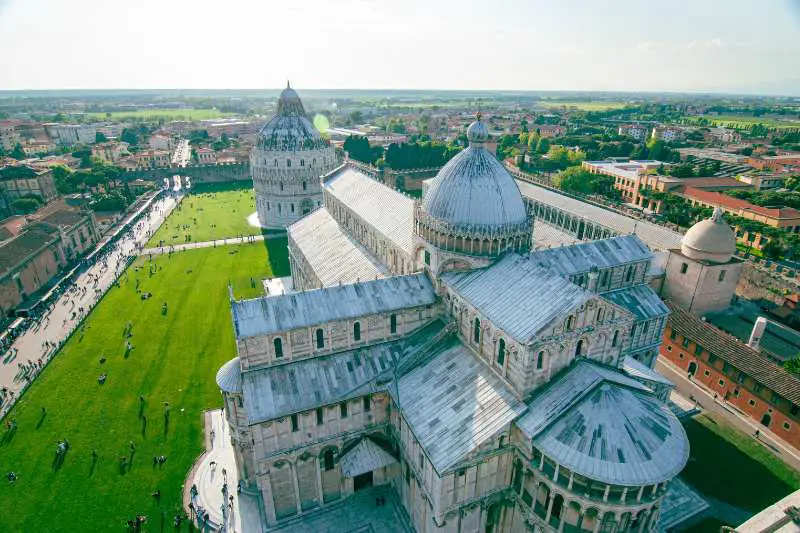
The Pisa Cathedral stands as a testament to Pisa’s grandeur during the Middle Ages, encapsulating centuries of history, art, and architectural evolution. This architectural masterpiece, with its stunning marble facade, showcases the wealth and artistic fervor of Pisa at the height of its maritime power.
Inside, visitors are greeted by a vast nave that illuminates the intricate frescoes, elaborate mosaics, and the pulpit by Giovanni Pisano, a masterpiece in itself. The cathedral’s blend of Romanesque and Gothic elements, along with its placement within the Piazza dei Miracoli, offers a spiritual and visual journey that connects visitors to the medieval soul of the city.
It’s not just a church; it’s a chapter of history carved in stone and adorned with the finest art, making it an indispensable visit for understanding Pisa and its place in the world.
2. Stroll through the Knights’ Square (Piazza dei Cavalieri)
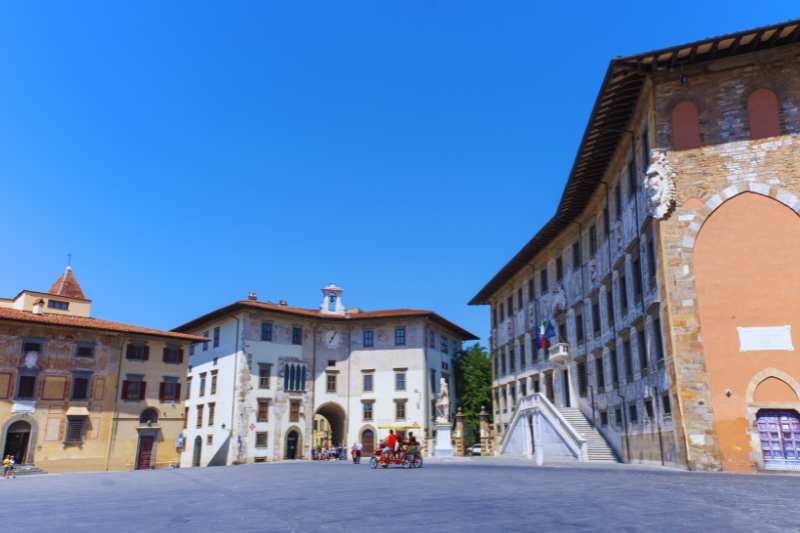
The Knights’ Square is a historical tapestry set in the heart of Pisa. Once the epicenter of power in the city-state, this square is framed by buildings that tell the story of Pisa’s evolution from a medieval powerhouse to a significant cultural and educational center.
The Palazzo della Carovana, with its façade designed by Vasari, houses the prestigious Scuola Normale Superiore. This institution exemplifies the square’s transformation into a beacon of learning and enlightenment.
The square’s architecture, bearing the marks of Renaissance ideals, and its historical significance as the headquarters of the Knights of St. Stephen, make it an essential destination for those looking to immerse themselves in the intellectual and political history that shaped modern Pisa.
3. Explore the Camposanto Monumentale

The Camposanto Monumentale, or “Holy Field,” is not just any cemetery; it’s a monumental cloister that borders the Piazza dei Miracoli. Its origins, tied to soil brought back from Golgotha during the Crusades, infuse the site with a profound sense of history and sanctity.
The structures within its walls contain a commendable collection of Roman sarcophagi, Gothic tombs, and frescoes that survived the devastation of World War II. Among these, the Triumph of Death is a hauntingly beautiful reminder of the transient nature of life.
This place of final rest, combined with its artistic treasures and serene atmosphere, provides a deeper contemplation of life, death, and the afterlife, framed by the unmistakable silhouette of Pisa’s monumental heritage.
4. Relax at the Botanical Garden of Pisa (Orto botanico di Pisa)

Established in 1544 by Cosimo I de’ Medici, the Botanical Garden of Pisa is a verdant oasis in the midst of the city’s ancient streets. As the first university botanical garden in Europe, it played a pivotal role in the development of botanical sciences and the study of plants from around the globe.
Today, it remains a haven of tranquility and scientific inquiry, showcasing an extensive variety of plants within its greenhouses, herb gardens, and arboretums. Its significance lies not only in its historical roots but also in its ongoing contribution to botanical research and environmental education.
For visitors, it offers a serene escape into nature, where one can appreciate the beauty and diversity of plant life, making it a refreshing counterpoint to the stone and marble of Pisa’s urban landscape.
5. Climb the San Michele in Borgo

Although less famed than the Leaning Tower, San Michele in Borgo offers an equally enriching experience. This historic church is not only a place of worship but also a vantage point offering breathtaking views of Pisa. Its ascent is a journey through layers of history, each step upward bringing you closer to the heavens and the city’s rooftops.
The panoramic vista from its heights encompasses a tapestry of red tiles, ancient streets, and the winding Arno River, framing Pisa in a way that can only be appreciated from above.
Moreover, San Michele in Borgo’s unique architectural features and historical significance make it a noteworthy destination for those interested in exploring the depth of Pisa’s ecclesiastical heritage.
6. Discover the National Museum of San Matteo (Museo Nazionale di San Matteo)
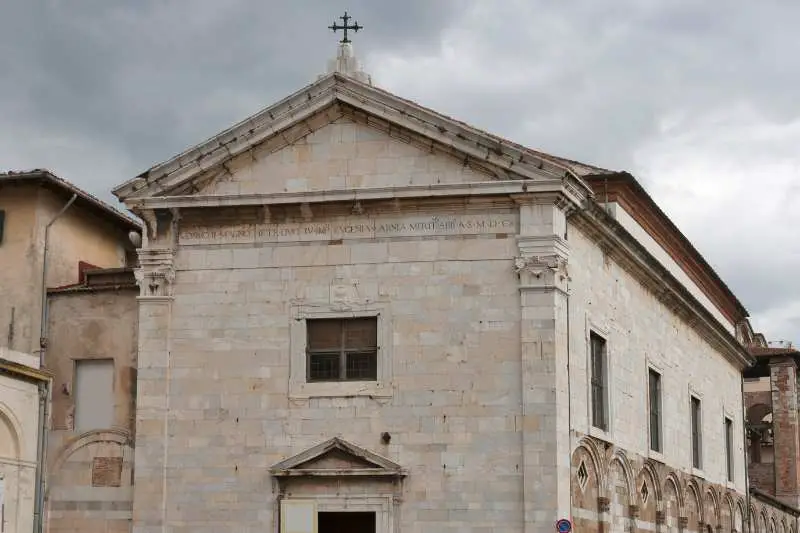
The National Museum of San Matteo is a treasure trove of Italian art, offering a comprehensive journey through Pisa’s artistic achievements from the Middle Ages to the Renaissance. Its collection includes masterpieces by renowned artists such as Giunta Pisano and Simone Martini, alongside remarkable examples of Tuscan sculpture.
The museum not only celebrates the aesthetic beauty of these works but also their role in the religious, cultural, and social life of the city. It serves as a captivating narrative of Pisa’s history told through art, highlighting the city’s position as a vibrant cultural hub.
For art lovers and history buffs alike, the Museo Nazionale di San Matteo is an essential stop, providing insights into the rich tapestry of Pisan and Tuscan artistry.
7. Walk Along the River Arno
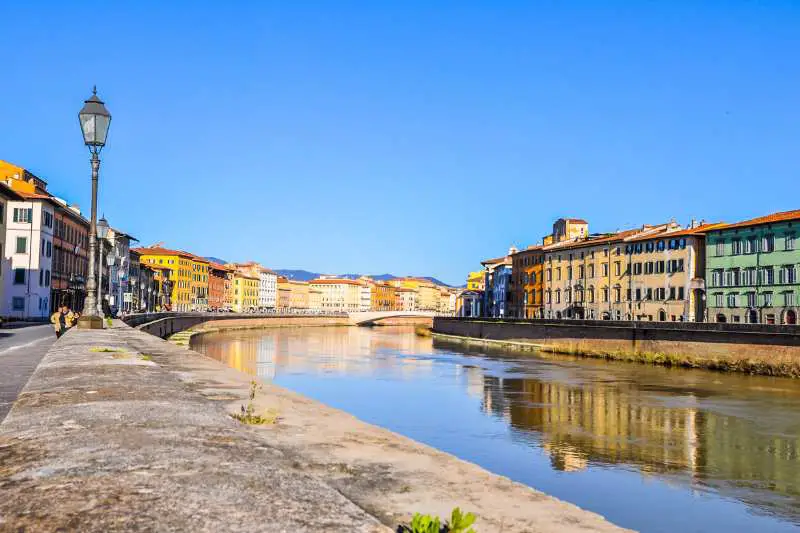
A stroll along the River Arno is akin to traversing the spine of Pisa, connecting the fabric of the city from its historical core to its living edges. The river, flanked by colorful buildings, historical bridges, and vibrant streetscapes, offers a picturesque window into the daily life of Pisani.
It’s here that one can truly sense the pulse of the city — a blend of leisurely strolls, bustling cafes, and the reflective calm of the water.
Walking along the Arno is to trace the lifeline of Pisa, where history, culture, and modern life intertwine gracefully, offering a moment of peace and contemplation amidst the city’s architectural grandeur.
8. Visit the Church of Santa Maria della Spina

The Church of Santa Maria della Spina, with its gothic spires reaching skyward, is a jewel of Gothic architecture. This small yet intricately adorned church was constructed in the 13th century, originally to house a thorn from Christ’s crown.
Despite its diminutive size, the church’s facade is a masterpiece of detailed sculpture and design, requiring one to pause and appreciate the craftsmanship. Its location on the banks of the River Arno adds to its picturesque charm.
9. Enjoy Pisan Cuisine at a Local Trattoria
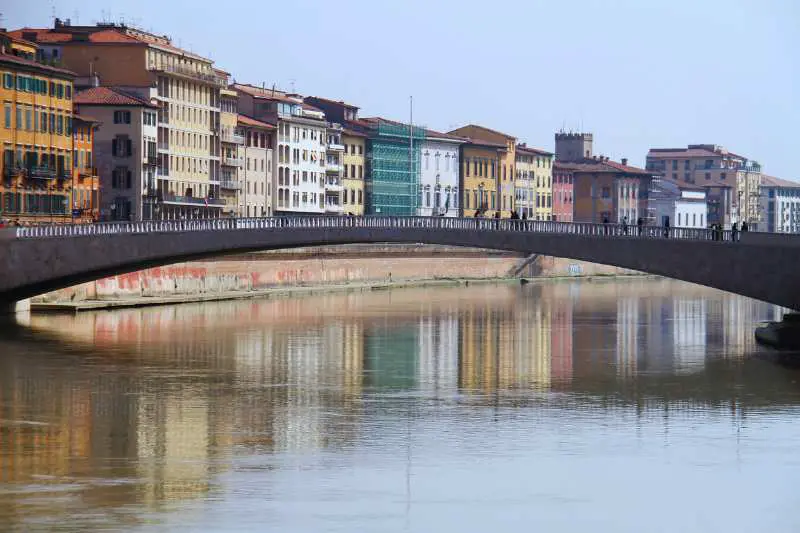
Pisa’s culinary scene is a hidden gem within the Tuscan gastronomy landscape, offering dishes that embody the simplicity, richness, and flavor of local ingredients. A meal at a local trattoria in Pisa is not just about eating; it’s an immersion into a tradition that celebrates the robust agriculture and vibrant seas surrounding the region.
Dishes such as cecina, a chickpea pancake, showcase the inventive use of humble ingredients, while the torta di riso, a sweet or savory rice cake, highlights the versatility of local produce.
Enjoying these dishes in the cozy ambiance of a trattoria, often run by generations of the same family, connects diners to the very soul of Pisan culture. It’s this blend of exceptional food, warm hospitality, and the timeless tradition that places dining at a local trattoria among the top things to do in Pisa.
10. Attend the Luminara di San Ranieri
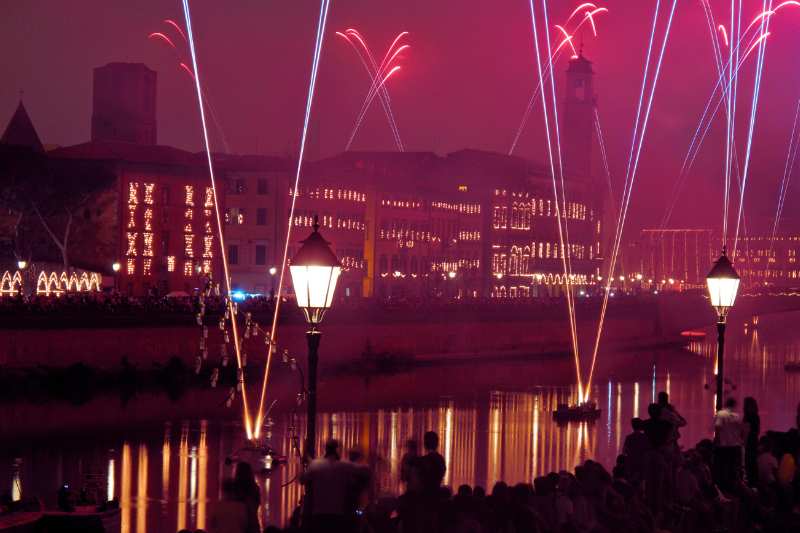
The Luminara di San Ranieri, held on the eve of June 17th, transforms Pisa into a canvas of light, honoring the city’s patron saint, San Ranieri.
On this night, the buildings along the Arno River are adorned with over 70,000 candles, their reflections dancing on the water’s surface, creating a spectacle of breathtaking beauty. The tradition dates back to the 17th century and is complemented by a stunning fireworks display that illuminates the Pisan sky.
Experiencing the Luminara offers a glimpse into the city’s deep-rooted traditions and community spirit, uniting both locals and visitors in a celebration of history, faith, and the transcendent beauty of light. It’s a once-a-year event that encapsulates the charm of Pisa, making it an unforgettable highlight of any visit.
11. The Leaning Tower of Pisa
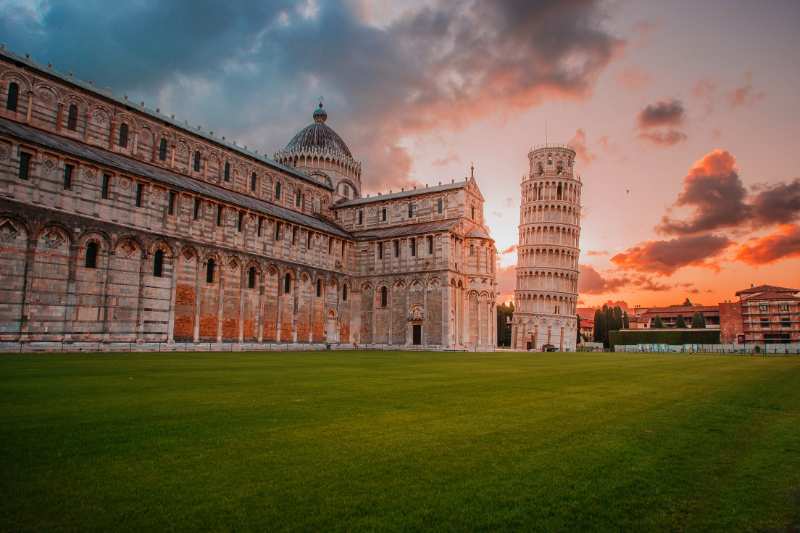
Of course, while Pisa offers much more than its Leaning Tower, the Leaning Tower of Pisa should definitely on your Pisa places to visit list.
Famous worldwide for its unintended tilt, the Leaning Tower of Pisa deserves recognition for more than just its lean. As the campanile, or freestanding bell tower, of the cathedral, its role was crucial in calling the faithful to prayer.
Constructed over 199 years, its design and gradual tilt became a marvel of medieval engineering, encapsulating the ambitions and achievements of Pisa during its maritime dominance. Climbing the tower’s 294 steps is a journey through history, providing unparalleled views of the Piazza dei Miracoli below and the city beyond.
Its survival through war, natural disasters, and the threat of collapse is a testament to the enduring spirit of Pisa and its people. The Leaning Tower is not just an architectural curiosity; it’s a symbol of resilience, beauty, and the enduring allure of human ingenuity, making it an essential visit for anyone coming to Pisa.
How To Get To Pisa
Reaching Pisa from elsewhere in Italy is a smooth and straightforward journey, thanks to the country’s efficient transport network. Whether you prefer the speed of a train, the convenience of a bus, or the privacy of a car, you’ll find a mode of transportation that suits your travel style.
If you’re starting from a major city like Rome, Milan, or Florence, the train is a fantastic option. Italy’s trains are fast, and offer scenic routes. The trip from Florence to Pisa, for instance, can be as short as 50 minutes, bringing you directly into the heart of the city.
For those on a budget, buses present an economical alternative without sacrificing comfort. Several bus companies operate routes to Pisa, allowing you to enjoy a leisurely trip through the Italian countryside before arriving at your destination.
Driving to Pisa allows for maximum flexibility and the opportunity to explore Tuscany’s picturesque landscapes at your own pace. The city is well-connected by a network of highways, making it easily accessible from major urban centers. Plus, driving gives you the freedom to stop at vineyards or charming villages along the way.
There’s also an international airport in Pisa with flights from many places in Italy and Europe.
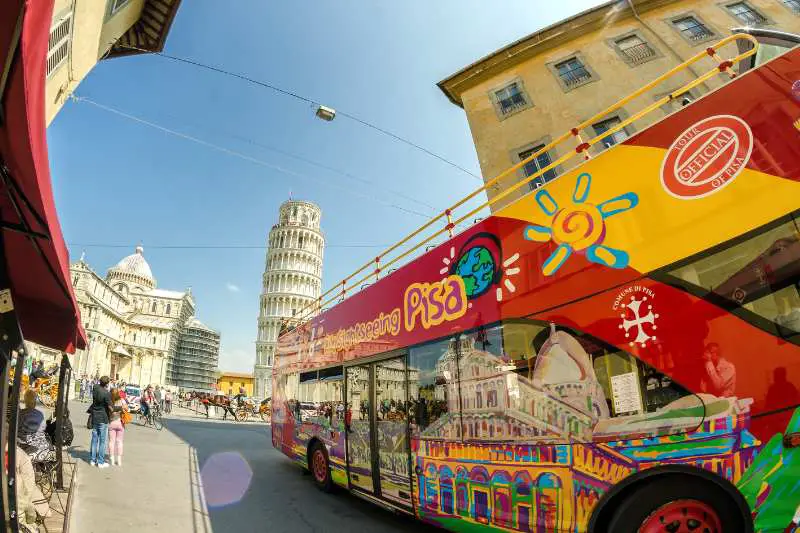
Final Words
Pisa is a treasure trove of cultural, historical, and culinary experiences that far surpass the fame of its Leaning Tower. From strolling along the Arno River to discovering hidden gems like the Santa Maria della Spina or indulging in the local culinary delights at a bustling market square, the city invites you to explore its every corner.
By extending your stay beyond a quick visit to the tower, you give yourself the opportunity to immerse in Pisa’s attractions, participate in its vibrant traditions, and create memories that are as enduring as the city’s storied past.
Pisa is a testament to the richness of Italian culture, waiting to be experienced in its full, vibrant, and glorious expanse. So, take the time to delve deeper and let Pisa reveal the depth of its beauty and charm beyond its famous tilt.
Find more guides to Central Italy here, including our guide to the best places to visit in Central Italy here. You can also click here to discover the best off-the-beaten-path places in Tuscany or here for our guide to nearby Siena.
